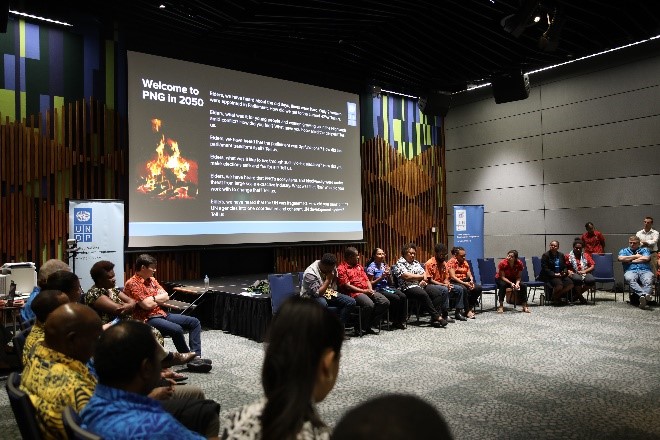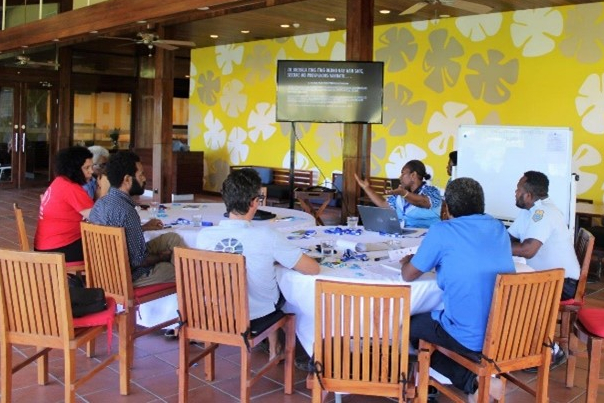Finding the future in the Pacific
March 30, 2023

One thing is clear: applying strategic foresight in the Pacific continues to be the need of the hour. In a region impacted by climate change and amid serious geopolitical risks, anticipatory action is a key pillar of delivering development. It helps us walk the thin line of adaptation-based and mitigation-based climate change interventions. It creates the space to talk about long term development while meeting short term goals.
In the last two years, we have used foresight for consultations (for example, inclusive imaginaries, climate security. AI-enabled dialogues), for policy making (e.g. Ministry of Internal Affairs Vanuatu – Nasara Strategy, Ministry of Health Fiji) and for development planning (e.g. COVID-19 Offer, Multi-country Programme Document – Fiji and Samoa and Papua New Guinea, Public Finance Management).
As an innovation practitioner designing and facilitating these co-creation processes, I have witnessed the promise of foresight: new ideas for interventions emerge, multiple stakeholders display shared ownership and an overall increased coherence in the ecosystem is materialized. While developing new imagination about current realities remains a challenge, I see three areas which have helped to create a fresh and robust narrative that speaks to our grand ambitions and innate desires for our futures.
Learning from the past: Intergenerational dialogue, talanoa, and oral storytelling
“In iTaukei traditional culture, as per the Rai Vakaviti, we do not look backwards to understand the past. The past is known, it is ahead of us. If we respect the past, the future will take care of itself. To respect the sacred precedents of the past (Liu) is to choose a peaceful future (Sautu).” – Itaukei protocol, Ministry of Indigenous Affairs, Fiji

Elders and young people of future in Papua New Guinea

Elders and young people of future in Papua New Guinea
In Papua New Guinea, we have worked with groups to convene campfire discussions where few individuals take up roles of “elders in the far future” and others act as “young people from the future” and have a free-flowing dialogue. Future youth ask the elderly questions about how society progressed over the years to create a future where all are thriving and prosperous. In such discussions, we see that those who occupy the roles of elders rely on ancestral wisdom of their own elders. It was almost as if time was seen as a loop, and we needed to look in our past for inspiration about the future. Post discussion, most in the room mentioned the need to ask their grandparents about what it was like in the past so that they can imagine the future.
The other benefit of this intergenerational setting was that the emergent nature of the dialogue allows for multiple futures to arise at the same time and broadens the art of the possible as elders build on each other’s imagination.
In Fiji, Talanoas act as a clever container for imagined futures. In addition to being a space for generating consent and consensus, with role play and a simple twist from Improv Comedy, it becomes a space for ripe storytelling. Furthermore, a campfire becomes a receptacle for a warm sharing which makes impossible suddenly plausible.
Solarpunk, Ecopunk and rise of Island Futures
In the indigenous tradition, we often hear of Deep Time. With roots in geology and in science fiction, deep time captures the time horizon on which one must consider the long-term impact of an intervention. In the Pacific, it includes seven generations: three generations in the past, the current generation and three generation in the future.

Community imagination sessions in Fiji

Community imagination sessions in Fiji
In our experience, pushing the boundary of the future has been challenging. People continue to operate within the traditional mindsets which generated the problems in the first place. Introducing ‘deep time’ allows for imagination to become provocative. By setting a scene that compels us to abandon our current curtailing mindsets, it allows newer realities to evolve. To create those contexts, we have heavily relied on ideas of solar punk and eco punk: where greenery is abundant, technology is employed in support of nature rather than against it and relies on renewable energies like solar, and capitalism is abolished to be replaced by communitarian societies.
By painting a future world in this light, we drip-feed the participants different ways of being and working in the future. In this future, they are not under pressure of other geopolitical powers, their fates are not tied to climate change targets of those that they cannot control. This future holds the promise of controlling their own destinies: their own version of sovereignty, self-sufficiency, and ecological balance.
Learning from the Pacific practice of anticipation
“Chief Roi Mata established the Nasara system throughout the archipelago of Vanuatu over 400 years ago of collaborative consultation for forward planning not only to meet to resolve conflict but also to meet the challenges of natural disasters and food shortages, important custom events marriages and trade. By combining the skills, strengths, energy, ideas and technical innovation of many villages, Roi Mata created a system that bought greater security, peace and prosperity to the islands of Vanuatu.”

Co-creation sessions with Ministry of Internal Affairs and stakeholders in Vanuatu

Co-creation sessions with Ministry of Internal Affairs and stakeholders in Vanuatu
When we first began experimenting with foresight, governance was an obvious choice. The Pacific could benefit from strong, anticipatory planning in the light of climate disasters. As we began our exploration, we looked for experts who could help us navigate this space. Very quickly, it became clear that the experts are right before us: the Pacific people are the key anticipatory planning experts.
They have been the first responders to environmental crises for centuries. Using their relationship with the land and sea, they have managed to create ways not only to navigate to reach their target but also find when the destination is not clear. They have an inherent comfort with uncertainty and ambiguity and are agile and adaptive in their approach.
In Vanuatu, our work with the Ministry of Internal Affairs produced a future-fit approach appropriately called ‘Nasara Strategy.’ The Strategy used the traditional concept of collaboration and consultation to investigate the past such that it could inform the future. Based on these consultations, we identified areas of risk/concern and worked with Directors in the Ministry to develop foresight briefs on those topics: decentralization, ODA coordination, youth engagement, and labor migration.
In addition to big data and predictive analysis, what we need to do more is create the avenues to harness this expertise and codify this approach. As we continue our experiments with new ways of doing policy, strategic planning, and design, we will further deep dive into these areas to create an inclusive, future-fit version of Pacific development.
To know more, write to Zainab Kakal: zainab.kakal@undp.org
A big thank you for co-conspirators across the UNDP offices in the Pacific: Fiji MCO, PNG CO and Samoa MCO.

 Locations
Locations